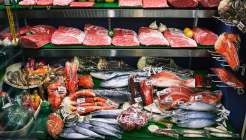Faux Feast
以假乱真的日本“美食”盛宴
A perfect replica requires imperfection. Take a grilled fish: Uniform all over, flawless in color and texture, it tells you nothing. But let’s say its silvery skin is marked with bubbles of assorted sizes, delicate crinkles and slightly uneven washes of carbonization. Let’s say the fish’s eyes are clouded over from the heat. And its markings, when you look closer, suggest it was flipped over the charcoal, showing you, under the gloss of its own rendered fat, a hot spot, where the heat on this nonexistent grill was more intense. Then, yes, maybe you want to buy that fish. Well, not that fish, which is made of plastic, but the fish it represents — the fish on the menu inside this particular restaurant.
瑕疵使仿制品看上去更完美。拿烤鱼来说:整条鱼外观均匀,颜色和质地完美无瑕,它不像真的。但是假设它的银色鱼皮上有大小不一的泡泡、细微的皱褶和稍有些不均匀的碳化痕迹。假设鱼眼由于炙热而变得浑浊。当你仔细查看的时候,它身上的痕迹暗示着它在炭火上被翻了个面,在它泛着光泽的油脂下面,火力在那个不存在的烤架上变得更猛了。然后,是的,也许你想买那条鱼。嗯,不是真的指那条鱼,它是塑料的,你想买的是它代表的鱼——在这家餐厅的菜单上的鱼。
The popular life-size food models known as shokuhin sampuru, displayed outside countless casual Japanese restaurants, function as promotional materials first, a way to boost sales. But the craftsmanship of a food model can be extraordinary — a fish so ridiculously crammed full of detail, so obsessively recreated, that you want the replica itself. No two fish look exactly the same at Ganso Shokuhin Sample-ya, a top-of-the-line shop in Tokyo operated by Iwasaki-Be-I, which displays the kinds of pieces the company makes for restaurants but also carries trinkets for tourists: cut bananas at varying stages of ripeness, bowls of pork cutlets on rice, sushi pieces and grilled fish. Some are better than others. That’s because each sample is made by hand — the work of 68 artisans across the company’s six factories.
这种与实物一般大小的食物仿制品很受欢迎,它们被称为“食品样品”,无数普通日本餐厅都将其摆放在店外做展示,首先作为宣传材料,用于促进销售。但食物仿制品的工艺有时实在是非同一般——一条鱼身上的细节多得不可思议,重塑过程近乎偏执,以至于你想要这个仿制品本身。东京的“元祖食品样品屋”由“岩崎Be-I”公司经营,是这类商店中的佼佼者,在这里找不到两条重样的鱼。店里展示公司为餐厅制作的食物仿制品,也有面向游客的小挂件:在不同成熟阶段切开的香蕉、猪排饭、寿司和烤鱼。制作的品质并不完全一样。这是因为每个仿制品都是由公司六家工厂里的68名工匠手工制作的。

颜色和质地完美无瑕的烤鱼、在不同成熟阶段切开的香蕉、令人垂涎欲滴的猪排盖饭……它们摆在日本餐厅的橱窗里,是餐厅宣传展示不必可少的工具,也记录着日本料理的发展史。
Sampuru, estimated to be a multibillion-dollar market in Japan and a growing market in Korea and China, have been used in restaurants for at least a century. In the 1920s, people shopping for clothing inside the Shirokiya department store ordered lunch based on the crude wax samples set up by the restaurant entrance. But this earlier generation of replicas had issues. Colors, already limited, faded quickly. Small parts snapped off. On a hot summer day, a restaurant with a sun-facing display case might wonder why no one was coming in, only to see that their replicas had deformed in the heat, melted grotesquely, putting everyone off Salisbury steaks.
据估计,这种一百多年前就已经开始使用的“样品”在日本拥有一个价值数十亿美元的市场,在韩国和中国的市场也在不断增长。1920年代,在白木屋百货店买衣服的顾客根据餐厅入口处摆放的粗蜡仿制品订购午餐。但是较早一代的仿制品是有问题的。本就选择有限的颜色很快会褪去。小零件会脱落。一家餐厅的展示柜向阳摆放,在炎热的夏日可能会奇怪为什么没有人进来,结果他们会发现仿制品在高温下变形了,融化后变得很难看,让人们对这道索尔兹伯里牛排失去了胃口。
By the 1970s, most sample makers switched over to more expensive, but longer lasting, plastic models, set in silicone molds and painted by hand. Takizo Iwasaki, who founded Iwasaki, worked to commercialize the process. More than half the company’s restaurant clients now rent, rather than buy, their samples (which makes sense when you consider that a particularly luxurious coelacanth replica at Iwasaki’s Ganso store retails for 2.1 million yen, almost $17,000).
到1970年代,大多食品仿制品制造商转向使用更昂贵但更耐用的塑料模型,在硅胶模具中浇铸成型并手工上色。创立岩崎Be-I的岩崎泷三致力于将这一过程商业化。该公司一半以上的餐厅客户现在租用而不是购买他们的仿制品(考虑到在岩崎的元祖商店里一个特别豪华的腔棘鱼仿制品的零售价为210万日元,将近1.7万美元,可以理解为什么要这么做。)
Yasunobu Nose, a journalist based in Tokyo, started documenting sampuru in Japan more than 20 years ago, after he noticed that regional deviations were reflected in food models. Eating the food confirmed a heap of differences, which meant the models had become a kind of growing physical archive of Japanese cuisine, documenting minute regional differences with every new custom order. Nose draws a line from the popularity of sampuru all the way back to the late Edo period, beginning in the 1800s, when food stalls in the city center sold tempura, soba and sushi, and displayed eye-catching finished dishes. A sample plate of soba indicated all kinds of vital information, from the portion for the price to the accouterments that came with it. These were sincere samples — the height of sample culture — disappearing by the end of each day and faithfully remade the next.
常驻东京的记者野濑泰申早在20多年前就开始记录日本的样品,因为他注意到食物样品反映了地区差异。品尝这些食物证实的确有许多差异,这意味着这些模型已经成为一种不断增长的日本料理实体档案,记录每一个新的定制订单中的微小地域差异。野濑从样品的流行一直追溯到江户时代后期——从1800年代开始,市中心的小吃摊出售天妇罗、荞麦面和寿司,并展示了引人注目的成品菜肴。一盘荞麦面样品显示了各种重要信息,从份量的价格到点缀。这些是货真价实的样品——样本文化的最高境界——在每一天结束时被撤下,并在第二天充满诚意地重新制作。
For The New York Times Magazine, the photographer Kyoko Hamada, who was born in Tokyo and now lives in the United States, documented a wealth of modern samples on Kappabashi Dogugai Street, also called Kitchen Town. The Tokyo street is packed with kitchen stores, where competing shops carry sampuru made all over the country, displayed in plastic packaging hanging from floor-to-ceiling wires, or in faux butcher cases and replica fish counters. “It’s kind of like they’re selling you a dream of the food,” she said. “It’s empty, you can’t eat it, but you see it, and then you get the feeling of wanting it.” She followed the samples at Ganso to a small factory, where workers mixed paints, then negotiated the matte pink of raw, aged fatty tuna, and the sheer, pale yellow of a curl of pickled ginger. “It was a funny reminder,” she said, after treating the pieces like art objects, “that they’re all made out of plastic, they’re all made out of the same ingredient, from the lettuce to the doughnut right next to it.”
受《纽约时报杂志》的委托,生于东京、目前在美国生活的摄影师滨田恭子(音)在人称厨房街的合羽桥道具街拍摄了大量新式的样品。这条东京街道上布满了厨具商店,用全国各地生产的食物模型吸引顾客,这些模型包裹着塑料膜,挂在从天花板垂下的绳子上,另外还有仿真的肉铺摊位和水产柜台。“就像在出售一个食物的梦,”她说。“里面是空的,不能吃,但能看见,然而你就觉得想吃。”她顺着元祖出售的样品找到了一家小作坊,工人们在那里混合颜料,调出肥美的金枪鱼肉经过熟成后的亚光粉色,还有腌渍姜片通透的浅黄色。“这是一个挺好玩的提醒,”把这些制品当艺术品看待的滨田说,“它们都是塑料的,无论是生菜还是旁边的甜甜圈,都使用同一种材料制作。”
When I asked Yuta Kurokawa, a representative for Iwasaki, what’s hardest for sample makers to recreate from the food world, he mentioned the shades of deep green found in fresh leaves and vegetables, but also the warmth of just-cooked foods — the sizzling edge of a pork cutlet right out of the pan, the steam escaping from a bowl of rice. “Samples look cold no matter what,” he said.
我问岩崎公司的代表黑川悠太(音),在样品制作中,最难仿制的是什么,他提到了新鲜叶子和蔬菜上会有的那种深绿色,还有刚刚烹制完成的食物会有的温度——比如刚出锅的猪排那滋滋冒泡的边缘,还有米饭的腾腾热气。“样品无论怎么做都是冷的,”他说。
This is true — they have no smell, no taste, no temperature. But every so often, a sample will do something that real food cannot, directing you to a single moment in the life of an ordinary dish and keeping you there, allowing you to take it in completely, and from every angle. It might be the second the egg was cracked for a bowl of tamago kake gohan, or the second after it, as the egg fell from the cook’s hands into a bowl of rice. The sample won’t allow the egg to pass into the oblivion of hot rice. It will hold that moment for as long as you like.
的确——它们没有气息、没有味道、没有温度。然而一件样品有时能实现真食物没有的效果,指引你来到一道普通菜肴生命中的某个瞬间,把你留在那一刻,全方位地去欣赏这道菜。也许是做生蛋拌饭时敲开鸡蛋那一刻,也许是蛋从厨师手中落到米饭上那一刻。样品不会让鸡蛋消失在热米饭里。它会抓住那一刻,你想看多久就看多久。
来源:好英语网

参与评论